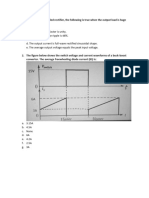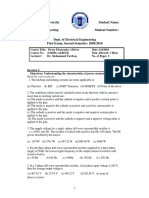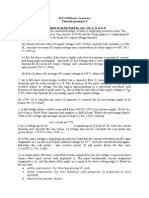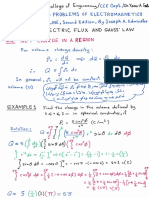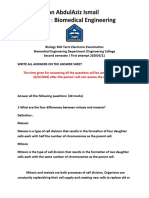Tutorial 2 - Uncontrolled Rectifier Circuits Revised
Uploaded by
Ayhan AbdulAzizTutorial 2 - Uncontrolled Rectifier Circuits Revised
Uploaded by
Ayhan AbdulAzizELEC4614 Power Electronics
University of New South Wales
School of Electrical Engineering & Telecommunications
Tutorial 2 - Rectifier circuits 1
1. A single-phase, half-wave rectifier is supplied from a 240V, 50Hz supply. Calculate the mean
load voltage and current for:
a) a 10 resistive load;
b) a load consisting of a 10 resistor in series with a 0.1H inductor.
[(a) 108V, 10.8A; (b) 58.7V, 5.87A]
2. A single phase half-wave controlled rectifier is connected to a 110V, 50Hz supply and to a load
consisting of a 10 resistor in series with a 50mH inductor.
If the firing angle of the thyristor is 45, derive an expression for the load current and
determine the extinction angle by iteration. Compare with the extinction angle given by the
conduction angle chart. Calculate the mean load voltage and current.
If a flywheel diode is connected, calculate the firing angle that will result in the same mean
voltage and current as before.
[239, 30.3V; 3.02A; 77]
3. A 100 V battery is to be charged via a single diode and series resistor from an ac supply with a
peak voltage of 200V. Calculate the value of the series resistor which will result in an average
charging current of 1 amp. Assume that the diode has a constant forward resistance of 2 and
that battery has a constant EMF of 100V and negligible internal resistance.
[19.8]
4. For a single phase, fully controlled bridge rectifier, derive an expression for the power supplied
to a resistive load as the firing angle is varied. If one thyristor becomes faulty and will not turn
on, calculate the firing angle which will give 25% of maximum possible load power. [HINT:
power is a function of RMS current]
[ V̂ 2 π α 0.5sin2α 2π R ; 90]
5. A heater with a resistance of 40 is supplied from a 240V ac supply. The heater power is to
be continuously variable between 100W and 1000W. Show that the necessary control can be
achieved by using a single phase, fully controlled bridge rectifier, and calculate the range of
firing angle required. Assume that a loss-less inductor is connected in series with the heater
to ensure ripple-free current, and allow for a forward voltage drop of 1.5V for each thyristor.
[72.2 to 20.1]
6. A single-phase fully controlled bridge rectifier supplies ripple-free current to a highly inductive
load. Derive an expression for the mean load voltage and also the rms value of the ac line
current assuming:
a) no flywheel diode;
b) a flywheel diode is connected.
[(a) V 2 V̂ cosα , I I ; (b) V V̂ [cosα 1] , I I πα ]
AV ac dc av ac dc
π π π
Uncontrolled Rectifiers 1 J Fletcher
ELEC4614 Power Electronics
Uncontrolled Rectifiers 2 J Fletcher
You might also like
- University of Zimbabwe: Power Electronics and Motion Control: Ee420No ratings yetUniversity of Zimbabwe: Power Electronics and Motion Control: Ee4208 pages
- V V V V: University of Saskatchewan EE 482.3 Power Electronics Assignment 5No ratings yetV V V V: University of Saskatchewan EE 482.3 Power Electronics Assignment 51 page
- 6 Single-Phase Controlled Rectifiers PDFNo ratings yet6 Single-Phase Controlled Rectifiers PDF22 pages
- Power Electronics Assignment FOUR MARKED-1-7No ratings yetPower Electronics Assignment FOUR MARKED-1-77 pages
- 11 - 19UEEPC501 - A - 4 - 3519UEEPC501 - Power Electronics - Unit2No ratings yet11 - 19UEEPC501 - A - 4 - 3519UEEPC501 - Power Electronics - Unit24 pages
- Single Phase Half Wave Controlled Rectifierpdf92% (37)Single Phase Half Wave Controlled Rectifierpdf14 pages
- Power Electronics (Ques - Ch2 - Rectifiers) PDF0% (1)Power Electronics (Ques - Ch2 - Rectifiers) PDF44 pages
- CH 3 - Controlled Rectifiers (Autosaved)No ratings yetCH 3 - Controlled Rectifiers (Autosaved)39 pages
- Philadelphia University Student Name: Faculty of Engineering Student NumberNo ratings yetPhiladelphia University Student Name: Faculty of Engineering Student Number2 pages
- Tutorial 3 - Phase Controlled AC-DC ConvertersNo ratings yetTutorial 3 - Phase Controlled AC-DC Converters3 pages
- Chapter 2- AC-DC Converters(Rectifiers)No ratings yetChapter 2- AC-DC Converters(Rectifiers)45 pages
- FALLSEM2021-22 EEE3004 ETH VL2021220100810 Reference Material I 16-Aug-2021 7 Controlled Rectifier NewNo ratings yetFALLSEM2021-22 EEE3004 ETH VL2021220100810 Reference Material I 16-Aug-2021 7 Controlled Rectifier New51 pages
- Unit - Ii - Phase Controlled RectifiersNo ratings yetUnit - Ii - Phase Controlled Rectifiers41 pages
- Power Electronics - Chapter 4 - Rectifiers AnalysisNo ratings yetPower Electronics - Chapter 4 - Rectifiers Analysis40 pages
- Power Electronics (Enee 4101) September 2018 Tutorial 1: D V V VNo ratings yetPower Electronics (Enee 4101) September 2018 Tutorial 1: D V V V8 pages
- Electrical-Engineering Engineering Power-Electronics Controlled-Rectifiers NotesNo ratings yetElectrical-Engineering Engineering Power-Electronics Controlled-Rectifiers Notes38 pages
- Lecture 1-Single-Phase-Controlled-RectifiersNo ratings yetLecture 1-Single-Phase-Controlled-Rectifiers41 pages
- III B. Tech I Semester Regular/Supplementary Examinations, October-2016 Power ElectronicsNo ratings yetIII B. Tech I Semester Regular/Supplementary Examinations, October-2016 Power Electronics6 pages
- Reference Guide To Useful Electronic Circuits And Circuit Design Techniques - Part 1From EverandReference Guide To Useful Electronic Circuits And Circuit Design Techniques - Part 12.5/5 (3)
- Design of Electrical Circuits using Engineering Software ToolsFrom EverandDesign of Electrical Circuits using Engineering Software ToolsNo ratings yet
- Lecture No.5: Current, Current Density, and ConductorsNo ratings yetLecture No.5: Current, Current Density, and Conductors12 pages
- Kinesiology: University of Duhok Biomedical Engineering DR Rayan Basheer100% (2)Kinesiology: University of Duhok Biomedical Engineering DR Rayan Basheer27 pages
- Lecture No.7: Capacitance and Dielectric MaterialsNo ratings yetLecture No.7: Capacitance and Dielectric Materials10 pages
- Lecture No.2: Coulomb Forces and Electric Field IntensityNo ratings yetLecture No.2: Coulomb Forces and Electric Field Intensity6 pages
- Lecture No.4: Electrostatics: Work, Energy, and PotentialNo ratings yetLecture No.4: Electrostatics: Work, Energy, and Potential16 pages
- Describe The Material Properties of Articular Connective TissueNo ratings yetDescribe The Material Properties of Articular Connective Tissue4 pages
- الحاسبات 1920 2 المعالجات المايكروية PDFNo ratings yetالحاسبات 1920 2 المعالجات المايكروية PDF63 pages
- Debug Programming: Table (1) The Debug CommandNo ratings yetDebug Programming: Table (1) The Debug Command3 pages
- Biology-Report-On-Issues-With-The-Human-Kidney, by Ayhan AbdulAziz IsmailNo ratings yetBiology-Report-On-Issues-With-The-Human-Kidney, by Ayhan AbdulAziz Ismail15 pages
- Biology Report On Issues With The Human KidneyNo ratings yetBiology Report On Issues With The Human Kidney12 pages
- Basic Operational Amplifier Circuits: Summing AmplifierNo ratings yetBasic Operational Amplifier Circuits: Summing Amplifier17 pages
- Lab Manual: Introduction To Circuits: Lab 4: Thevenin and Norton EquivalentsNo ratings yetLab Manual: Introduction To Circuits: Lab 4: Thevenin and Norton Equivalents29 pages
- Biology Mid Term Electronic Examination, by Ayhan AbdulAizi IsmailNo ratings yetBiology Mid Term Electronic Examination, by Ayhan AbdulAizi Ismail29 pages
- I/O Pads: In, Out, Inout, GND, VDD, Source FollowerNo ratings yetI/O Pads: In, Out, Inout, GND, VDD, Source Follower18 pages
- Terminologies In: Electrical Installation &maintenance (Ncii)No ratings yetTerminologies In: Electrical Installation &maintenance (Ncii)24 pages
- 18" Subwoofer: Ferrite Magnet Aluminium Basket DriverNo ratings yet18" Subwoofer: Ferrite Magnet Aluminium Basket Driver1 page
- Measurement of The Surface Electrical Resistance of SnO2:F Thin FilmsNo ratings yetMeasurement of The Surface Electrical Resistance of SnO2:F Thin Films6 pages
- Ecodrive03 Drive Controllers: Project Planning ManualNo ratings yetEcodrive03 Drive Controllers: Project Planning Manual344 pages
- Chapter 01 Fundamentals Lecture 01.04 Thevenin's and Norton's TheoremsNo ratings yetChapter 01 Fundamentals Lecture 01.04 Thevenin's and Norton's Theorems3 pages
- Lecture 1 - Introduction To Power SystemNo ratings yetLecture 1 - Introduction To Power System53 pages
- ENE - Combined Updated For Use of AY2020No ratings yetENE - Combined Updated For Use of AY20202 pages
- Datsun Electrical Service Guide Service Manual100% (62)Datsun Electrical Service Guide Service Manual9 pages



























